Comprehensive Guide to Hazardous Waste Water Treatment Procedures
Comprehensive Guide to Hazardous Waste Water Treatment Procedures
Blog Article
Strategic Approaches to Boost Waste Water Treatment Performance and Minimize Environmental Effect
In the world of drainage therapy, the pursuit for enhanced effectiveness and minimized ecological influence is a continuous challenge that demands critical options. As society comes to grips with the important to take care of water resources sustainably, a nuanced method ends up being crucial. The integration of sophisticated treatment technologies, energy-efficient processes, resource recuperation strategies, enhanced nutrient elimination strategies, and clever surveillance and control systems stands for a complex structure for resolving these pushing worries. What exists at the core of this complex web of techniques is the prospective to reinvent the means we approach waste water therapy, not simply as a process of disposal, but as a useful possibility for technology and ecological stewardship.
Advanced Therapy Technologies
Cutting-edge membrane layer filtration systems have actually revolutionized innovative wastewater treatment procedures, substantially enhancing the elimination of contaminants. This innovation has actually verified to be very effective in getting rid of a broad variety of impurities, consisting of pharmaceuticals, hefty steels, and natural substances, which are frequently testing to eliminate through conventional treatment techniques.
In addition, membrane filtering systems use various benefits over conventional treatment methods. In addition, these systems are extremely functional and can be easily incorporated into existing therapy plants or made use of as standalone units for decentralized applications.
Energy-Efficient Procedures
The assimilation of energy-efficient processes in wastewater treatment systems is crucial for enhancing resource application and minimizing operational expenses. By implementing energy-efficient technologies, treatment plants can substantially lower their carbon footprint and total environmental effect. One vital method to improving power efficiency in wastewater treatment is the use of innovative aeration systems, such as great bubble diffusers or surface area aerators, which can improve oxygen transfer performance and reduce power usage. In addition, including energy recuperation systems, like anaerobic food digestion for biogas manufacturing or utilizing excess warmth for thermal processes, can aid counter power demands and advertise sustainability.
Furthermore, optimizing process control and automation with using sophisticated sensors and keeping an eye on systems can improve general power efficiency by adjusting procedures in real-time based on actual need and conditions. Applying power audits and regularly keeping track of energy efficiency signs are important methods to determine locations for renovation and track energy-saving campaigns effectively. On the whole, the fostering of energy-efficient procedures in wastewater treatment not only benefits the atmosphere yet likewise adds to long-lasting cost savings and functional sustainability.
Resource Recuperation Strategies
With a focus on enhancing source use and sustainability in wastewater therapy systems, the implementation of source recovery techniques arises as an essential element in boosting operational efficiency. Source recuperation methods in wastewater treatment include the identification and removal of beneficial resources from the waste stream, thereby turning what was as soon as thought about waste into a valuable asset. By implementing source healing strategies such as nutrient removal and recovery, energy generation from raw material, and the production of multiple-use water, wastewater therapy plants can decrease environmental influence while maximizing effectiveness.

Improved Nutrient Removal Techniques
Implementing innovative nutrient elimination strategies is essential for maximizing the effectiveness of wastewater therapy systems. One of the crucial strategies made use of for improved nutrient elimination is the process of organic nutrient removal (BNR), which includes the removal of nitrogen and phosphorus with organic processes.
In enhancement to BNR, progressed therapy techniques such as membrane layer bioreactors (MBRs) and created marshes can likewise be utilized to boost nutrient removal performance. By integrating these sophisticated nutrient elimination strategies right into wastewater treatment industries, systems and districts can efficiently decrease nutrient pollution and protect the environment.
Smart Tracking and Control Solution
Utilizing advanced innovation, the integration of smart surveillance and control systems changes the operational effectiveness of wastewater treatment centers. These systems incorporate innovative sensing units and information analytics to constantly monitor crucial criteria such as pH degrees, turbidity, liquified oxygen, and flow prices in real-time. By gathering and assessing this information, operators can gain useful understandings right into the efficiency of the therapy procedures, enabling proactive changes to optimize therapy performance.
Smart surveillance and control systems also support remote monitoring capacities, permitting operators to gain access to real-time information and control functions from off-site locations. This remote ease of access improves functional flexibility and responsiveness, allowing swift treatments in case of system breakdowns or fluctuations in influent high quality. The anticipating upkeep abilities of these systems assist protect against devices failings and decrease downtime, inevitably improving the overall integrity of wastewater treatment procedures.
Final Thought
To conclude, strategic strategies click over here such as innovative therapy technologies, energy-efficient procedures, resource recuperation methods, boosted nutrient elimination techniques, and wise surveillance and control systems play a critical role in enhancing wastewater therapy performance and reducing environmental influence. By executing these techniques, wastewater therapy plants can enhance their general efficiency, decrease power consumption, recover important sources, and ensure compliance with ecological guidelines. These strategies are important for sustainable and reliable wastewater administration methods.

In verdict, critical techniques such as advanced treatment technologies, energy-efficient processes, resource recovery strategies, visite site boosted nutrient removal methods, and wise monitoring and control systems play an important role in enhancing wastewater therapy efficiency and decreasing environmental impact.
Report this page